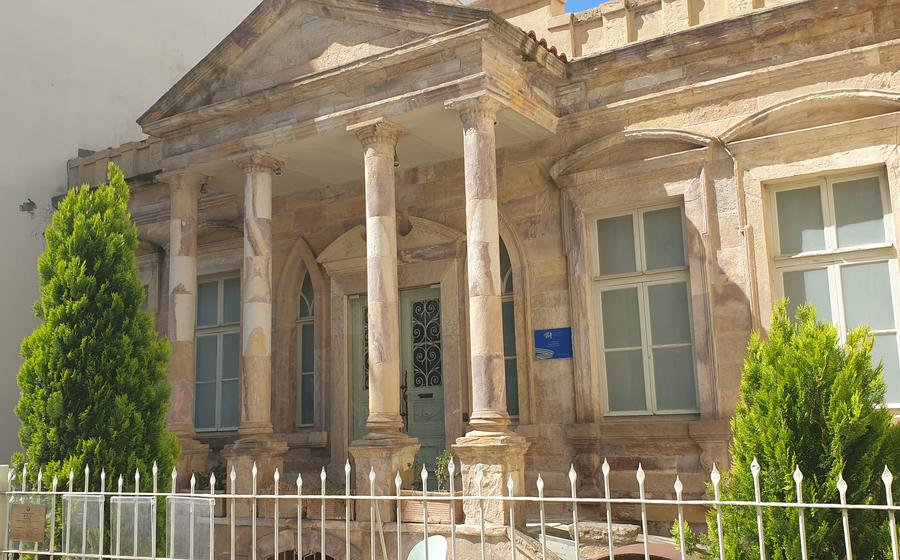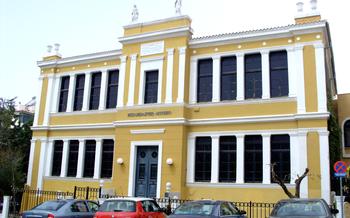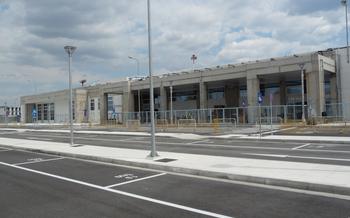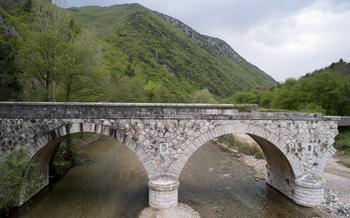
Ethnological Museum of Thrace
- Ethnological Museum of Thrace: A Journey into Cultural Heritage
- The People of Thrace: A Tapestry of Traditions
- A Glimpse into Rural Life: The Traditional House
- The Art of Thrace: Handicrafts and Souvenirs
- Local Cuisine: A Culinary Adventure
- The Healing Power of Nature: Traditional Medicine
- Music and Dance: Expressions of Joy and Identity
- Thrace in the Ottoman Era: Influences and Legacies
- A Walk through History: Archaeological Discoveries
- Celebrating Diversity: Festivals and Events
- The Thrace Folklore Archives: Preserving Oral Traditions
- Educational Programs and Workshops
- Community Involvement and Outreach
- Insider Tip: Discover Hidden Treasures
Ethnological Museum of Thrace: A Journey into Cultural Heritage
Nestled in the heart of Alexandroupoli, the Ethnological Museum of Thrace invites visitors on a captivating journey through the cultural heritage of the region. Delve into the rich history of Thrace, a melting pot of civilizations and traditions, as you explore an unparalleled collection of artifacts that bring the past to life. From traditional costumes and intricate handicrafts to sacred objects and domestic utensils, the museum offers a comprehensive insight into the diverse ethnic groups that have shaped the region's unique identity.
Step into the museum's galleries and embark on an educational adventure. Learn about the region's fascinating folklore and legends, gaining a deeper understanding of the beliefs and customs that have been passed down from generation to generation. Immerse yourself in the traditional way of life, as you discover the intricate details of rural architecture, domestic tools, and the role of women in shaping the fabric of society.
Visiting the Ethnological Museum of Thrace is an enriching experience that celebrates the cultural diversity of the region and provides a glimpse into the soul of its people. Whether you're a history buff, an art enthusiast, or simply curious about the local traditions, this museum offers an unforgettable journey into the heart of Thrace's cultural heritage.
The People of Thrace: A Tapestry of Traditions
Thrace is a region renowned for its vibrant cultural heritage, shaped by the diverse ethnic groups that have called this land their home. Greeks, Turks, Armenians, and Pomaks have all contributed to the unique tapestry of traditions that define the region. The Ethnological Museum of Thrace provides a glimpse into the lives and customs of these communities, showcasing their traditional costumes, jewelry, and everyday objects.
Traditional costumes are a testament to the region's rich cultural diversity. The vibrant colors and intricate designs of Greek, Turkish, and Armenian garments reflect the unique identities of each community. Visitors can marvel at the intricate embroidery and delicate fabrics that adorn these traditional outfits, each telling a story of cultural heritage.
Customs and traditions are deeply ingrained in the fabric of Thrace's society. From weddings to religious festivals, each occasion is marked with unique rituals and celebrations. The museum offers a glimpse into these customs, showcasing the objects and artifacts used in traditional ceremonies. Visitors can learn about the significance of these rituals and how they have been passed down through generations.
Local folklore and legends are an integral part of Thrace's cultural identity. The museum's collection includes a wealth of stories, myths, and legends that have been passed down orally for centuries. These tales often revolve around historical events, local heroes, and supernatural beings, providing a fascinating insight into the region's rich oral tradition.
Preserving cultural identity is of paramount importance to the people of Thrace. The Ethnological Museum plays a crucial role in safeguarding and promoting the region's diverse heritage. Through its exhibits, educational programs, and community outreach initiatives, the museum ensures that the traditions and customs of Thrace continue to thrive and be celebrated for generations to come.
A Glimpse into Rural Life: The Traditional House
In the heart of Thrace, nestled amidst rolling hills and verdant plains, lies a treasure trove of architectural heritage: the traditional Thracian house. Step into these abodes, and you'll be transported to a time when simplicity and functionality reigned supreme.
The houses showcase a unique blend of local materials and ingenious design. Constructed primarily of stone and wood, they reflect the region's rich natural resources. Thick stone walls provide insulation against the harsh elements, while wooden beams and rafters lend a sense of warmth and coziness.
Inside these humble dwellings, you'll find a tapestry of traditional tools and utensils that tell the story of everyday life in rural Thrace. Handcrafted looms, spinning wheels, and pottery adorn the rooms, revealing the industrious nature of the people who once lived here.
Family life and social customs played a central role in these traditional houses. The hearth, the heart of the home, served as a gathering place for families to share meals, stories, and laughter. The women of the household held a pivotal position, managing domestic chores, weaving intricate textiles, and nurturing family bonds.
Visiting these traditional houses offers a glimpse into a bygone era, where simplicity, hard work, and community spirit were the cornerstones of rural life. Immerse yourself in the rich cultural heritage of Thrace as you explore these architectural gems, each one a testament to the region's enduring traditions.
The Art of Thrace: Handicrafts and Souvenirs
Thrace is renowned for its vibrant and diverse handicrafts, reflecting the region's rich cultural heritage. Traditional weaving, embroidery, and pottery are among the most popular crafts, showcasing the skill and creativity of local artisans.
Traditional Weaving and Embroidery:
The art of weaving and embroidery holds a special place in Thrace's cultural identity. Skilled artisans create intricate patterns and designs using colorful threads, often depicting traditional motifs and symbols. From intricate rugs and carpets to delicate tablecloths and cushion covers, these handmade textiles are a testament to the region's textile heritage.
Pottery and Ceramics:
Thrace's potters are known for their exceptional craftsmanship and unique style. Using local clay and traditional techniques, they create a variety of functional and decorative pottery pieces. From hand-painted plates and bowls to decorative vases and figurines, each piece is a unique work of art.
Souvenirs and Local Crafts:
The Ethnological Museum of Thrace offers a curated collection of souvenirs and local crafts, providing visitors with an opportunity to take a piece of Thrace's cultural heritage home. From intricately carved wooden items to handmade jewelry and traditional musical instruments, these souvenirs are not just mementos but also a testament to the region's artistic traditions.
Supporting Local Artisans:
By purchasing handicrafts and souvenirs from the museum, visitors directly support local artisans and craftsmen, helping to preserve and promote traditional skills and livelihoods. The museum works closely with local artisans to ensure that their products are authentic and reflect the true essence of Thrace's cultural heritage.
Local Cuisine: A Culinary Adventure
The Ethnological Museum of Thrace also delves into the rich culinary traditions of the region. Thrace's cuisine is a harmonious blend of diverse influences, reflecting its historical and cultural crossroads. Visitors can learn about traditional dishes and ingredients, cooking techniques, and the significance of food in cultural identity.
The museum showcases an array of traditional recipes, highlighting local specialties and must-try dishes. From hearty stews and flavorful grilled meats to fresh seafood and delectable pastries, the cuisine of Thrace offers a tantalizing journey for food enthusiasts.
One of the highlights of the museum's culinary exploration is the opportunity to taste and savor authentic dishes prepared using traditional methods and local ingredients. Visitors can indulge in the flavors of Thrace by participating in cooking demonstrations or attending special events and workshops focused on regional cuisine.
Through these culinary experiences, the Ethnological Museum of Thrace not only preserves and promotes local food traditions but also provides visitors with a deeper understanding of the region's cultural heritage and the role of food in shaping its identity. It's a delightful and immersive way to learn about the diverse gastronomy of Thrace and savor the region's culinary delights.
The Healing Power of Nature: Traditional Medicine
In the heart of Alexandroupoli, the Ethnological Museum of Thrace harbors a fascinating collection that delves into the ancient practices of traditional medicine. Discover the healing secrets passed down through generations, revealing the remarkable power of nature's remedies.
Traditional healers, known as "yiaτροσοφοι" or "γιατροσοφισσες," played a crucial role in rural communities, relying on herbal remedies and natural therapies to treat ailments and promote well-being. Explore the museum's exhibits to learn about the various medicinal plants used, their properties, and the methods of preparation.
Discover the art of herbalism, where healers crafted intricate recipes using flowers, leaves, and roots to create healing potions, ointments, and tinctures. Witness the tools and equipment they employed, including mortars, pestles, and distillation apparatus, providing a glimpse into the alchemy of traditional medicine.
Uncover the beliefs and practices that shaped the healing traditions of Thrace. Explore the role of religion and spirituality in traditional medicine, where prayers, incantations, and rituals were believed to enhance the healing power of natural remedies.
Delve into the fascinating world of traditional healing, where nature's bounty was harnessed to promote health and well-being. The Ethnological Museum of Thrace offers a unique opportunity to connect with the ancient wisdom and practices that have shaped the cultural heritage of the region.
Music and Dance: Expressions of Joy and Identity
Thrace's rich cultural heritage is expressed through its vibrant music and dance traditions. Traditional musical instruments, such as the lyra, gaida, and daouli, create enchanting melodies that accompany energetic dances like the tsakonikos and sirtos. Local dances are not merely performances; they are expressions of joy, identity, and community spirit. Music festivals and cultural events are held throughout the year, offering visitors a chance to immerse themselves in the region's musical and dance traditions. Participating in these events allows one to witness the passion and skill of local performers, connect with the community, and experience the infectious energy of Thrace's musical heritage firsthand.
Thrace in the Ottoman Era: Influences and Legacies
The Ottoman Empire's reign over Thrace, lasting nearly five centuries, left an indelible mark on the region's history and culture. During this period, Thrace served as a crossroads of civilizations, with various ethnic and religious communities coexisting under Ottoman rule. The influence of the Ottoman era is still visible in the region's architecture, cuisine, and social customs.
One of the most striking legacies of Ottoman rule in Thrace is the architectural heritage it left behind. The construction of mosques, bridges, and fortifications transformed the landscape, blending Islamic and Byzantine architectural styles. The iconic Selimiye Mosque in Alexandroupoli, built in the 16th century, stands as a testament to the architectural prowess of the Ottoman period. Its intricate tilework, elegant minarets, and imposing dome are a reminder of the grandeur of the Ottoman Empire.
Beyond architecture, the Ottoman era also influenced the region's cuisine. The introduction of new ingredients and cooking techniques, such as the use of spices and the grilling of meats, enriched the local gastronomy. Traditional dishes like "giouvarlakia," meatballs in a tomato sauce, and "pilafi," a rice dish with meat or vegetables, are remnants of this culinary fusion.
The Ottoman Empire's impact on Thrace extended beyond its architectural and culinary heritage. The coexistence of different communities under Ottoman rule led to cultural exchanges and intermingling of traditions. The region became a melting pot of languages, religions, and ethnicities, shaping the diverse and tolerant society that Thrace is known for today.
Thrace's history under Ottoman rule is not without its complexities and conflicts. There were periods of tension and resistance, as well as instances of cooperation and harmony. Understanding this era's nuances is crucial for comprehending the region's present-day identity. The Ethnological Museum of Thrace offers visitors a glimpse into this rich and multifaceted period through exhibits, artifacts, and historical accounts.
A Walk through History: Archaeological Discoveries
Thrace is a treasure trove of archaeological wonders, boasting ancient settlements and sites that offer a glimpse into the region's rich past. Excavations have unearthed fascinating ruins, artifacts, and historical remains that shed light on the region's diverse civilizations.
The ancient city of Abdera, founded in the 7th century BC, is one of the most significant archaeological sites in Thrace. Excavations have revealed impressive fortifications, temples, and public buildings, providing insights into the city's political and cultural life. The site also features a well-preserved theater and an agora, where lively markets and gatherings once took place.
Another notable site is the ancient city of Maroneia, located near the coast. Founded in the 6th century BC, Maroneia was a thriving port city and a major wine producer. Excavations have uncovered impressive city walls, a well-preserved temple dedicated to Dionysus, the god of wine, and a theater. The city's rich history is further evidenced by the discovery of numerous tombs, offering glimpses into the burial customs and beliefs of the ancient inhabitants.
Thrace is also home to several ancient fortresses and castles, remnants of the region's turbulent history. Perched on strategic hills or along the coastline, these fortifications served as defensive structures against invaders and played a crucial role in the region's military history. The Byzantine fortress of Didymoteicho, with its imposing walls and towers, is a testament to the region's strategic importance during the Byzantine era.
These archaeological discoveries provide valuable insights into the lives, cultures, and achievements of the ancient civilizations that once flourished in Thrace. By exploring these sites, visitors can embark on a journey through time, uncovering the hidden stories and mysteries of the region's past.
Celebrating Diversity: Festivals and Events
Thrace comes alive with a vibrant calendar of festivals and events throughout the year, showcasing the region's rich cultural heritage and diverse traditions. These celebrations offer a unique opportunity to immerse yourself in the local way of life and witness the passion and dedication of the Thracian people.
One of the most renowned events is the International Thrace Festival, held annually in the summer. This grand celebration features a spectacular array of traditional dances, music, and performances from across the region, attracting visitors from near and far.
Don't miss the Alexandroupoli Carnival, a riotous and colorful affair that fills the streets with laughter, music, and elaborate costumes. This lively festival is a testament to the region's exuberant spirit and its love for life.
For a taste of rural traditions, head to the Traditional Village Festival held in various villages throughout the year. These charming events showcase local crafts, traditional food, and folk music, providing a glimpse into the authentic lifestyle of Thrace's villages.
Whether you're interested in experiencing the vibrant energy of a modern festival or delving into the timeless customs of rural life, Thrace's festivals and events offer an unforgettable immersion into the region's diverse cultural tapestry. Make sure to check the local calendar to plan your visit around these exciting celebrations.
The Thrace Folklore Archives: Preserving Oral Traditions
Nestled within the Ethnological Museum of Thrace lies a treasure trove of oral traditions, myths, and legends—the Thrace Folklore Archives. This invaluable collection safeguards the rich cultural heritage of the region, ensuring that the stories, customs, and beliefs of its people are not lost to time.
The archives serve as a repository for a diverse range of oral expressions, including folktales, songs, riddles, proverbs, and legends. Through meticulous documentation and preservation efforts, these traditions are meticulously recorded, cataloged, and made accessible to researchers, scholars, and the general public.
The significance of the Thrace Folklore Archives lies in its role as a guardian of cultural identity. Oral traditions are an integral part of Thrace's living heritage, passed down from generation to generation through storytelling and communal gatherings. By preserving these traditions, the archives contribute to the continuity and vitality of the region's cultural fabric.
Moreover, the archives provide a valuable resource for researchers and scholars seeking to delve into the depths of Thrace's history, customs, and beliefs. The collected materials offer insights into the region's social, economic, and cultural transformations over time, shedding light on the lives and experiences of its people.
Visiting the Thrace Folklore Archives is an immersive journey into the heart of the region's oral heritage. Visitors can explore the archives' collection, listen to captivating stories narrated by local storytellers, and gain a deeper understanding of the rich cultural tapestry that defines Thrace.
Educational Programs and Workshops
The Ethnological Museum of Thrace offers a variety of educational programs and workshops designed to engage visitors of all ages in the region's rich cultural heritage. These programs provide hands-on learning experiences that allow participants to delve deeper into the traditions and customs of Thrace.
Children can participate in interactive workshops that introduce them to traditional crafts, storytelling, and music. They can learn about the art of weaving, pottery, and embroidery, creating their own unique souvenirs to take home. Storytelling sessions bring to life the legends and myths of Thrace, capturing the imagination of young minds.
Adults can also participate in workshops that explore specific aspects of Thrace's cultural heritage. Cooking classes teach participants how to prepare traditional dishes using local ingredients, while music workshops introduce them to the region's unique musical instruments and genres.
These educational programs and workshops not only enhance the museum experience but also contribute to the preservation and promotion of Thrace's cultural heritage. By engaging visitors in hands-on activities, the museum ensures that the traditions and customs of the region continue to be passed down from generation to generation.
Community Involvement and Outreach
The Ethnological Museum of Thrace extends its influence beyond its walls, actively engaging with the local community and fostering a sense of cultural belonging. Collaborations with educational institutions, such as schools and universities, play a crucial role in promoting cultural awareness and education among the younger generation. The museum organizes workshops, seminars, and educational programs tailored to students of all ages, providing hands-on experiences and interactive learning opportunities.
Furthermore, the museum collaborates with local organizations and artisans to promote and support traditional crafts and skills. By providing a platform for local artisans to showcase and sell their products, the museum contributes to the preservation and revitalization of traditional arts and crafts. This not only supports the livelihoods of local artisans but also ensures the continuity of cultural heritage.
The museum's outreach initiatives extend to community events, festivals, and cultural celebrations. By participating in these events, the museum engages with a broader audience, showcasing its collection and promoting cultural awareness. These events provide opportunities for visitors to experience traditional music, dance, crafts, and cuisine, fostering a sense of community pride and cultural identity.
Insider Tip: Discover Hidden Treasures
Beyond the main exhibits, the Ethnological Museum of Thrace holds hidden treasures waiting to be discovered by curious visitors. Explore the museum's lesser-known corners and you might stumble upon unique artifacts, intriguing stories, and captivating insights. Ask the friendly museum staff about their favorite exhibits or hidden gems. They are often delighted to share their knowledge and provide a deeper understanding of the museum's collection. Take advantage of this opportunity to engage with experts and uncover the untold stories behind the artifacts. Embrace your curiosity and let the museum's hidden treasures enrich your visit, leaving you with lasting memories and a deeper appreciation for the cultural heritage of Thrace.




